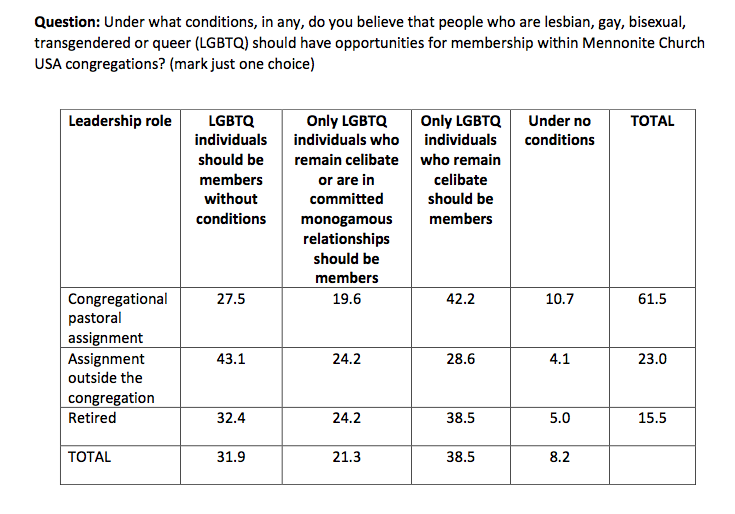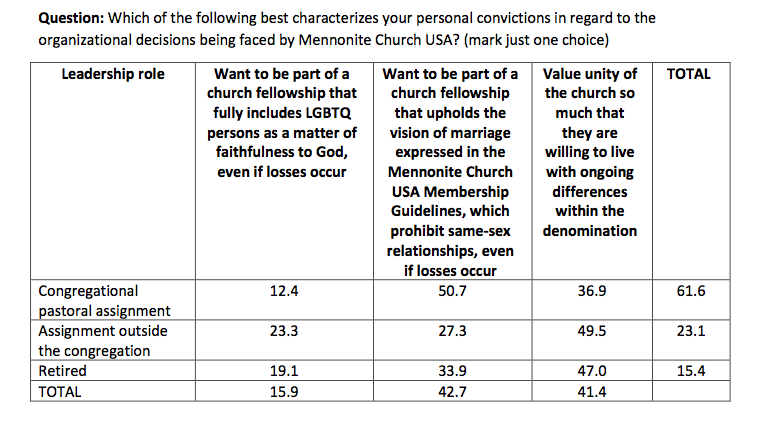Are you too lazy to read the survey on GLBTQ issues that just came out? Do you want a totally biased, subjective, moderately educated perspective on the 2014 Survey of Credentialed Leaders in Mennonite Church USA? So I present to you: Clergy Sexuality Survey: TL;DR (more to follow, if I feel like it).
Totally Biased Summary, Part 1: The People
Remember what I said in the last post about some of the respondent bias? Essentially, in the Mennonite Church, credentialed clergy (those who are pastors, retired pastors, or working in church leadership like chaplaincy or specific missions) are disproportionately male and three-quarters of them are 45+. There’s no statistics on race for the survey, but (spoiler alert) they’re mostly white.

MC USA clergy are 6% more female than the 2015 Congress. Make your own metaphor about the church being 6% more effective than Congress.
Totally Biased Summary, Part 2: Their Issues
There are at least some intelligent people reporting on the survey results on the internet. There are also lots of people just venting. Here are some of the highlights they’re arguing about:
How inclusive is inclusive?
If you look at the overall numbers, there seems to be a slight preference for including LGBTQ people as members in congregations. 53.2% of all leaders believe LGBTQ should be members “without conditions” or if they are “celibate or in committed monogamous relationships.” About 40% of active pastors in congregations think only celibate LGBTQ people should be members; about the same number of people who are working in placements outside the congregation want inclusion, no exceptions. Retired people are pretty evenly split. Very few people believe LGBTQ people should never, under any conditions, become members–less than 10% overall.
When it comes to LGBTQ people becoming pastors, the number of people opposed doubles. However, more than three-quarters of people think it’s okay for celibate GLBTQ people to be in church leadership. This doesn’t even include the opinions on whether or not it’s okay for (heterosexual) pastors to perform LGBTQ marriages.
What does “celibate or in a committed monogamous relationship” (CMR) even mean?
I wish I knew. Do all CMRs mean marriage? What if you’re LGBT and dating? What if you’re divorced from a long-time CMR? If you selected this answer, please use the comments and tell me what you meant.
Is it all about the youth?
“Among 18- to 35-year-olds, 66% support LGBTQ membership.” Is it just a waiting game, then? Will the church necessarily become more inclusive as the younger generations grow up? Probably. Questions about young clergy views, however, are largely speculative and beside the point.

There are quite probably more left-handed clergy than there are clergy under 35 in the Mennonite Church.
This group is only 9% of the total. In any other organization, people would be saying, “Why the hell is less than 10% of your workforce under 35?” In the church we’re asking, “If young people stay in church, won’t something change?” What is wrong with us?
Why is the 36-45 age group of pastors the most conservative about sexuality issues?
We don’t know. All we can say is 45% of this age group wants GLBTQ members. It might be that this demographic–who are busy raising children and establishing their careers–are most invested in the status quo and maintaining stability. Or, that most LGBTQ people–and their allies–in this age group have already left the church; the younger group of LGBTQ/allies are still burning their youthful hope and haven’t yet become disillusioned with the church. Another suggestion is that older pastors (45+) become more inclusive as their children–and their friend’s children–come out to them. Or, it could be something else entirely.
Who leaves and who stays?
If we look at pastors–and pastors don’t always have much control over whether their church stays or leaves–50% of pastors want the Church to keep its current stance (against LGBTQ marriage/membership) “even if losses occur.” On the flipside, only 12% of pastors want to be part of an LGBTQ inclusive church “even if losses occur.”
This is generally being interpreted (so far as I’ve seen) as “Conservatives are willing to cut people off, but liberals are not.” However, the phrasing is passive: “even if losses occur.” At this point, many, many more anti-inclusion churches are threatening to leave than pro-inclusion. Even though conservative churches are more willing to “lose” members, my hunch is that those who favor inclusion are going to stay anyway. GLBTQ people and allies see the tide turning; they see popular opinion, in the secular world, tilting toward inclusion. If they’ve stayed this long, they’re likely not going to leave now. On the flipside, churches that oppose inclusion feel like they need to take a hard line to defend the status quo by rejecting LGBTQ people outright–and if the LGBTQ people won’t leave, they will.
So even though these numbers seem to favor churches that keep LGBTQ people at a distance–I doubt that’s the case. If MC USA stays the way it is, it’s more likely to lose the churches that are opposed to GLBTQ membership. Additionally, when you look at the overall numbers, an almost the same amount–41%–want to keep things the way they are as want to “live with ongoing differences.”
Who cares? (Or, what is this information going to be used for?)
There’s a committee somewhere out there working on a Resolution (capital R) Kansas City Convention this summer. That Resolution, which will take this data into account, will be presented to the delegate body (the Mennonite legislate body) so we can make a Decision (capitol D) that may or may not change anything about our beliefs, authority, and church structure. My hope is that the delegate body won’t swallow a Resolution whole. That the don’t rubber-stamp the committee’s work. The delegate body has a lot of power. And if all they want to do is sit around and say “we like each other. we’re not voting on shit if it’s going to ruin our friendship.” That’s valid, too. That’s good.


Thanks for the writeup, this is definitely an interesting survey. I took a quick pass through the document of tables the final report and was disappointed to see that they only ever break the data down by one demographic at a time. I was hoping to be able to look at trends by age and gender, or congregational assignment status and age.
The big surprise for me was the variance between pastors based on assignment status (congregational, non-congregational, retired). I expected the geographic, urban-rural, gender, and age differences, but I did not expect this one. If we had all the data we could try to see if it is due to the demographics of pastes who have various assignment types, but we just don’t have that info. I should note that when further looking through the report that 60% of respondents were in congregational rolls where only 30% were in non-congregational rolls.
Other things I was disappointed about (and maybe I just didn’t read the survey carefully enough – I need to now go back and thoroughly read the final report):
– The first few tables clearly state the sample size (N=xxxx), each one has a different number. Why is this? do they need another column in the table for “did not respond”?
– Once I hit page 4, I noticed most of the remaining tables don’t have Ns.
– After looking through the final report I saw all sorts of data that should have been in the tables (the actual percentages of respondents assignment statues (church, non-church, retired)
– There was no mention of education level in the tables document, but it was in the report, however there is no systematic reporting by level of education
– There is no mention of approach, and I don’t see the survey published anywhere. I don’t really have the research background to be able to judge those even if we did have them, but I would have liked to run them by people who do.
I find this report interesting and I think, in principal, that having a better understanding of how people in MCUSA view these issues is generally a good thing. Part of the challenge here is that this report leaves me with as many questions about what was left out of the report as it does about what is in the report. I don’t know the players involved in the report (ether Conrad L. Kanagy, the author, or whoever else was involved in it), but I was not left with a strong feeling that all of the interesting data was included and everything else is simply uninteresting. This is not to suggest that I have any reason to believe that anything of particular interest was omitted, but I can’t tell and it seems like there is lots of potential for other interesting comparisons that could have been done. I would love to see some research/data people weigh in on their thoughts around this report.
And I bet most people who decide to study religion think they won’t ever need math…
LikeLike